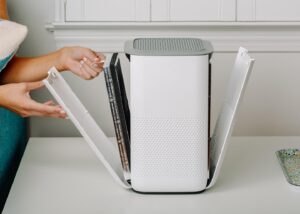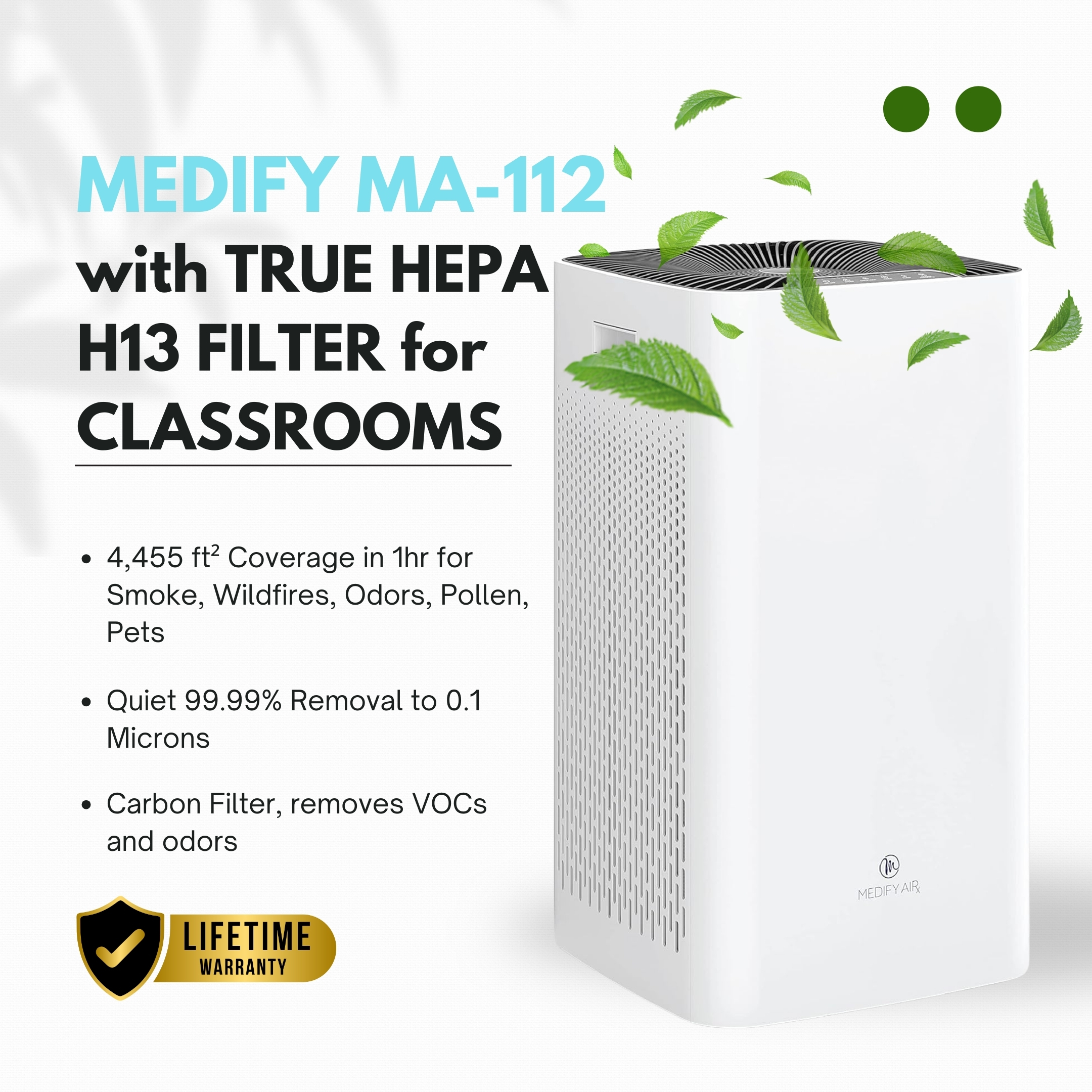Breathe Easy: How Air Purifiers Are Helping Keep Classrooms Safe from COVID-19 This Back-to-School Season

As students return to in-person learning, maintaining a safe and healthy environment is a top priority for schools. One of the key tools in reducing the spread of COVID-19 in classrooms is the use of air purifiers. COVID-19 primarily spreads through airborne droplets and particles, especially in indoor spaces with poor ventilation. Air purifiers equipped with high-efficiency particulate air (HEPA) filters can capture a significant portion of these airborne particles, including those that may carry the virus.
By constantly circulating and filtering the air, air purifiers help reduce the concentration of viral particles in a room, making it less likely that students and teachers will inhale them. This is particularly important in classrooms where maintaining distance or improving natural ventilation, like opening windows, may not always be feasible due to weather or other constraints.
Moreover, air purifiers can work alongside other preventive measures such as mask-wearing, regular hand-washing, and vaccinations. Together, they create a layered defense that enhances the safety of indoor learning environments. Schools that invest in high-quality air purifiers not only reduce the risk of COVID-19 transmission but also promote overall better air quality, benefiting students’ respiratory health in the long term.
In light of the ongoing pandemic, both schools and parents are increasingly recognizing the critical role of air purifiers in ensuring a safer, healthier back-to-school season.
Choosing the Right Air Purifier: What Schools and Parents Need to Know
With air purifiers playing a key role in reducing COVID-19 transmission indoors, it’s important for schools and parents to choose the right devices to ensure maximum effectiveness. Not all air purifiers are created equal, and understanding key features can help make informed decisions that protect students and staff.
The most important feature to look for in an air purifier is a high-efficiency particulate air (HEPA) filter. HEPA filters are highly effective at trapping small airborne particles, including viruses, allergens, and other pollutants. To be considered true HEPA, the filter must capture at least 99.99% of particles that are 0.1 micron in size, which includes the typical size range of respiratory droplets that can carry the COVID-19 virus. Schools should prioritize air purifiers that are certified with this technology to ensure they are filtering out harmful particles.
Another critical factor is the size of the room the air purifier is intended for. Air purifiers come with a Clean Air Delivery Rate (CADR), which indicates how much filtered air the device can produce per minute. Schools and parents should select air purifiers that match or exceed the square footage of classrooms or other indoor spaces to ensure effective air circulation. For large classrooms, a single small unit may not suffice, and multiple air purifiers may be needed to provide thorough air cleaning.
Noise levels are also an important consideration, especially in classrooms where concentration and communication are key. Many air purifiers offer quiet modes or variable fan settings, so choosing models that are effective yet not disruptive to learning environments is a priority.
Finally, maintenance and upkeep should be factored in. Regularly replacing filters is essential for the air purifier to remain effective. Schools should ensure they have access to replacement filters and the budget for ongoing maintenance. Some devices have filter replacement indicators to make this process easier, allowing staff to keep the units running at optimal levels. As Steve Fontaine, “America’s Indoor Air Quality Expert”™, suggests, HEPA filters should not be vacuumed or washed but replaced to ensure maximum efficiency and air quality.
By carefully selecting air purifiers based on these criteria, schools can ensure that their classrooms are equipped with the right tools to reduce COVID-19 transmission and protect the health of both students and staff. For parents considering air purifiers at home, these same guidelines apply, helping to maintain a safer environment for their children after school as well.
Get a Free Indoor Air Quality Consultation Today
Ensure a Healthier Environment for Your School or Office!
Related Posts:

Steve Fontaine: America’s Indoor Air Quality Expert
Steve Fontaine: America’s Indoor Air Quality Expert Steve Fontaine – “America’s Indoor Air Quality Expert” ™ Steve Fontaine, “America’s Indoor

What is HEPA 13/14 Filter?
Everything You Need to Know About HEPA 13/14 Filters Understanding HEPA 13/14 Filtration Standards High-Efficiency Particulate Air (HEPA) filters are

Why Should I Care?
Why Should I Care? Fontaine’s extensive knowledge and experience in this field make him a valuable resource for understanding the
Beyond the Classroom: How Air Purifiers Benefit Students' Overall Health
1. Reduces Allergens
- Air purifiers equipped with HEPA filters can trap pollen, dust mites, and pet dander, reducing allergy symptoms such as sneezing, coughing, and itchy eyes.
- For students with asthma or severe allergies, cleaner air can mean fewer absences due to illness or allergic reactions.
2. Minimizes Respiratory Issues
- Poor indoor air quality can trigger respiratory conditions, especially in children with preexisting conditions like asthma. Air purifiers help remove irritants like smoke, mold spores, and volatile organic compounds (VOCs) that can aggravate breathing problems.
- Cleaner air leads to fewer respiratory infections, allowing students to breathe more easily and stay healthy throughout the school year.
3. Improves Concentration and Cognitive Performance
- Studies show that good air quality can enhance concentration, memory, and overall cognitive performance. Students learning in cleaner air environments are less likely to feel fatigued or distracted, improving their ability to focus and perform academically.
- Reducing airborne pollutants can also minimize headaches, which can disrupt concentration and classroom engagement.
4. Promotes Better Sleep
- Airborne allergens and irritants can disrupt sleep patterns, especially for children with respiratory conditions. Cleaner air at home helps children sleep more soundly, leading to better energy levels and focus during the school day.
- Adequate sleep is linked to better learning outcomes, improved mood, and greater physical health.
5. Supports Mental Well-being
- Air quality can also impact mental health. Poor air quality is associated with an increase in stress, anxiety, and even depressive symptoms in some cases. Cleaner air promotes a calmer, healthier environment, supporting students’ emotional and mental well-being.
- This is particularly important in school settings, where the mental well-being of students is closely tied to their academic performance and social interactions.
6. Helps Control the Spread of Other Illnesses
- Beyond COVID-19, air purifiers help reduce the spread of other viruses, bacteria, and common illnesses like the flu or cold, contributing to a healthier school community overall.
- Reducing airborne germs means fewer absences due to illness, keeping more students in the classroom and engaged in learning.
Got questions? Contact us or get free consultation.
Adherence to Guidelines from:
- World Health Organization
- CDC
- EPA
Expert in the field of IAQ
Our seasoned advisors provide trusted solutions to secure your family's or employees' health.
Each case is handled alone
Personalized approach to address your specific air quality needs effectively and efficiently.
Chat with an expert any time
Access our expert advice whenever you need it, ensuring continuous support for your air quality concerns.
Helped install 1.2 Million air purifiers
Proven track record of enhancing indoor environments with our comprehensive air purification solutions.







